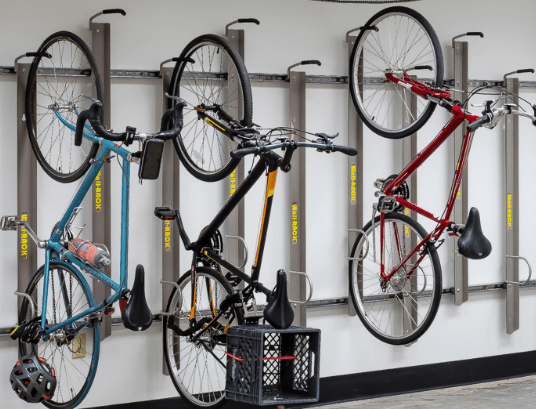What is a Vertical Bike Rack and How Does It Work?

In urban environments and spaces where real estate is at a premium, efficient bike storage solutions have become increasingly important. One such innovation is the vertical bike rack. This type of rack provides an ingenious way to store bicycles vertically, making it an attractive option for residential and commercial settings. But what exactly is a vertical bike rack, and how does it work? Let’s dive into the details.
Understanding Vertical Bike Racks
A vertical bike rack is a storage system designed to hold bicycles upright, effectively utilizing vertical space. Unlike traditional bike racks, which often occupy significant horizontal space, vertical racks can store multiple bikes in a smaller footprint. They are especially popular in places with limited space, such as apartment complexes, urban bike-sharing stations, and crowded bike shops.
See also: How to Store A Vertical Bike Rack
Types of Vertical Bike Racks
Vertical bike racks come in various designs, each catering to different storage needs and bike styles:
Wall-Mounted Racks: These racks attach directly to a wall, allowing the bike to hang vertically. They often include hooks or cradles to secure the bike frame.
Freestanding Vertical Racks: These standalone units can be placed anywhere, usually designed to hold several bikes. They often come with a base that stabilizes the structure.
Lift Systems: Some advanced vertical bike racks feature mechanical systems that allow users to lift and lower their bikes with minimal effort. These systems can be particularly beneficial for heavier bikes or in settings where users might struggle to lift their bikes manually.
Stackable Racks: These racks allow for stacking multiple bicycles, effectively doubling or tripling storage capacity. They typically feature adjustable heights to accommodate various bike sizes.
How Vertical Bike Racks Work
The operation of a vertical bike rack varies depending on its design, but the general principles remain similar:
Loading the Bike: Most vertical racks require the user to lift the bike into position. For wall-mounted racks, users hang the bike by the frame or wheels, securing it in place with hooks or straps. Freestanding racks often have designated slots or cradles that guide the bike into position.
Securing the Bike: Many vertical racks include features to secure the bike, such as straps, locks, or adjustable clamps. This added security helps prevent theft and ensures that the bike remains stable in its position.
Retrieving the Bike: To retrieve the bike, users simply reverse the process, lifting it off the rack or releasing it from its locked position. In the case of mechanical lift systems, users can activate a mechanism that brings the bike down to a more accessible height.
Space Efficiency: By storing bikes vertically, these racks can significantly increase the number of bicycles that can be housed in a given area. This efficiency is especially beneficial in crowded urban settings or for businesses that need to accommodate a high volume of bikes without sacrificing space.
Benefits of Vertical Bike Racks
Space-Saving: The most significant advantage of vertical bike racks is their ability to maximize space. By utilizing vertical rather than horizontal storage, these racks can accommodate more bikes in a smaller area.
Improved Organization: Vertical bike racks help keep bicycles organized, reducing clutter in shared spaces. This organization can make it easier for users to find their bikes and can contribute to a more appealing environment.
Enhanced Security: Many vertical racks come with built-in locking mechanisms, providing an extra layer of security. Users can secure their bikes more effectively compared to traditional racks, which may not offer the same level of protection.
Aesthetic Appeal: Vertical bike racks can be designed with aesthetics in mind, blending into the architectural style of buildings or public spaces. This design consideration can enhance the overall look of an area, promoting a bike-friendly culture.
Accessibility: For users who may struggle with lifting heavier bikes, particularly e-bikes or cargo bikes, vertical racks with lift mechanisms can provide a user-friendly solution, making bike storage accessible to a broader range of individuals.
Considerations When Choosing a Vertical Bike Rack
When selecting a vertical bike rack, several factors should be considered:
Space Available: Measure the area where the rack will be installed to ensure a good fit.
Bike Types: Consider the types of bikes being stored, as some racks may not accommodate certain styles, like fat bikes or those with unusual frame designs.
User Base: For public installations, think about the demographics of users. Are they experienced cyclists, or will they include beginners who may need more assistance?
Security Features: Look for racks that provide options for locking bikes securely.
Conclusion
Vertical bike racks are an innovative solution to the growing demand for efficient bike storage. By utilizing vertical space, these racks offer significant benefits in terms of space efficiency, organization, and security. Whether for a home, office, or public space, vertical bike racks can enhance the biking experience, making it easier for cyclists to store and access their bicycles. As cities continue to embrace cycling as a sustainable mode of transportation, vertical bike racks will play an essential role in promoting a bike-friendly infrastructure.




